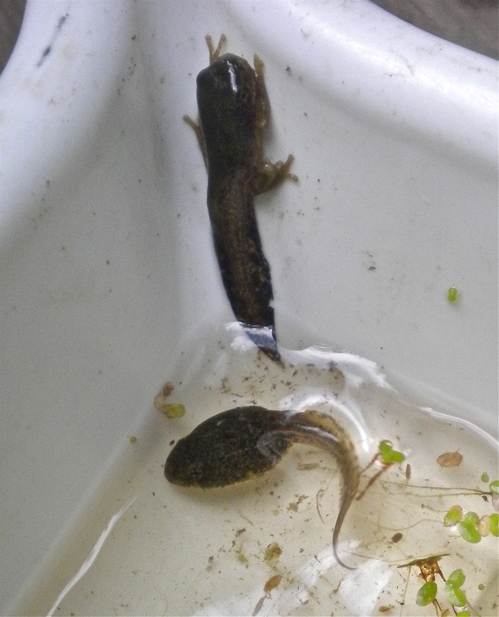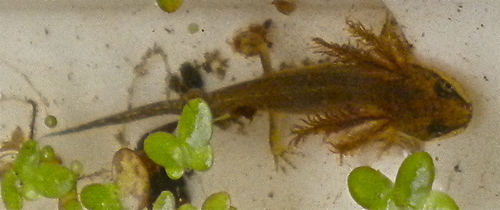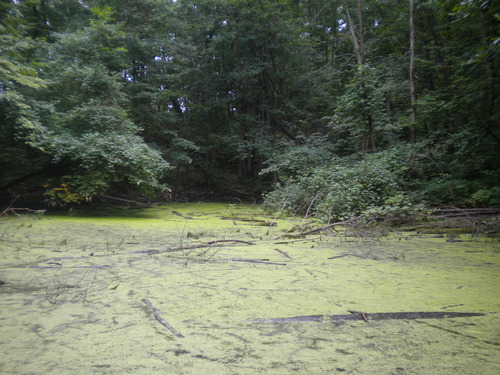Pondcast 29: Baby newts are so cute
On July 18 volunteers from the City of Ann Arbor’s Natural Area Preservation Division Salamander Survey descended onto Black Pond to discover what amphibians were growing in the waters. Led by David Mifsud, city herpetologist, we learned how to safely collect, identify and release amphibian larvae.
The term, larvae, refers to the form of a young animal that undergoes metamorphosis. Humans refer to various animal larvae using specific terms. Frog larvae are tadpoles. Moth and butterfly larvae are caterpillars. Flies are maggots. Beetles are grubs. Humans are tykes.

Dragonfly nymphs dine on aquatic insects including the larvae of mosquitoes and phantom midges.
Insects that undergo simple (or incomplete) metamorphosis, like dragonflies, damselflies, and grasshoppers are nymphs. Nymphs are more or less smaller versions of adults, perhaps with underdeveloped body parts, like wings. On this day, we encountered a dragonfly nymph and proceeded to watch it hunt and eat phantom midge larvae.

Green frog tadpoles - the one with legs hatched in a previous summer and is nearly done metamorphosing.
Green frog tadpoles were the most commonly collected amphibians. The adults were still mating - males were calling, females were listening, a male/female pair was observed in amplexus. Amplexus is the position in which a male frog has climbed onto the back of a female to fertilize the eggs as she lays them. Like the green frog, most frog fertilization is external.
Several green frog tadpoles that hatched this year were collected. These youngsters did not yet possess legs. Whereas the green frog tadpole with legs and a long tail we collected hatched last year and survived the winter in the damp mud beneath the pond. This older tadpole was able to climb up the side of the observation tray.

Eastern newt larva.
Salamander larvae and adults were, indeed, discovered. Of these, larvae of the eastern newt (Notophthalmus viridescens) were the most common.
Of the amphibians in Ann Arbor, eastern newts are perhaps the most complex and interesting. As tadpoles that live in water, they possess external gills that are reminiscent of moose antlers. Juveniles, called efts, are bright red and live on land. Adult newts are green on top and yellow on bottom and return to the water to live, except for when conditions are very dry. Some populations of newts become reproductively mature while remaining in the juvenile form while other populations mature in the juvenile eft stage.
Throughout their lives, newts are carnivorous. Larvae eat the smaller pond organisms, like daphnia, insect larvae and snails. Juvenile efts and land-dwelling adults eat small invertebrates found in leaf litter. Adult newts eat most any small aquatic invertebrate they can catch. Newts have toxic skin secretions so are generally unpalatable to predators, except for leeches.
The reproductive life of eastern newts is quite unique. Humans might find it rather interesting. Males wiggle in the water to display the dark spots on their underside. This wiggling causes the males to release a pheromone. Once a female is attracted to a dancing male and his perfume, she allows the male to rub her snout. Like salamanders, the male drops a sperm packet onto the bottom of the pond, which is picked up by the female and placed inside her cloaca to fertilize eggs. Occasionally, an additional male might notice the snout rubbing and place his sperm underneath the amorous couple in hope that the female picks up the wrong packet.
Females lay 200-400 eggs throughout a period of several weeks, laying only one fertilized egg at a time on underwater plants. So throughout the summer, it is common to find newt larvae of various sizes.

Black Pond on July 18.
You can see all the Pondcast videos by visiting the YouTube channel of Stefan Szumko, AKA slugwhisperer at http://www.youtube.com/user/slugwhisperer.
Stefan Szumko is a middle school science teacher by trade, an outdoor environmental educator by calling, and a homedaddy by choice. He can be reached at slugwhisperer@gmail.com.


Comments
Monica Milla
Thu, Aug 19, 2010 : 5:42 a.m.
I've always wanted to do the salamander survey, but have done the frog/toad for the last few years. Frogs are just freaky--I mean they go from being aquatic to having lungs!